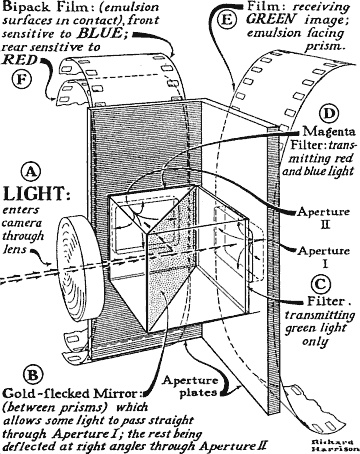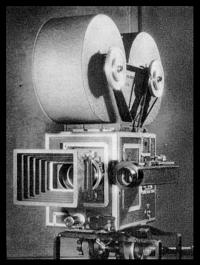 Technicolor's Camera
 The diagram above shows a simplified interior of the Technicolor three-component camera. It should really be studied in connection with the Appendix explaining the theory of the Technicolor process (page 168). Further advice is to start at point A and follow the artist around the diagram letter by letter. The diagram above shows a simplified interior of the Technicolor three-component camera. It should really be studied in connection with the Appendix explaining the theory of the Technicolor process (page 168). Further advice is to start at point A and follow the artist around the diagram letter by letter.
 The only difference between the camera as it is and the camera as you might expect it to be from the nature of the process lies in the use of the bipack film. As you see in the diagram, the light entering the prism strikes the gold flecking - a screen of fine gold particles that act as mirrors and deflect part of the light, the rest passing through. So the light splits into two rays at right angles to each other. One ray goes through the green filter and reaches the green negative. The other ray goes through a magenta filter, which permits the passage of both blue and red light. Back of the magenta filter are two strips of film, one behind the other. The front film is coated with yellow dye. The yellow dye prevents the passage of blue light. Therefore, when the blue and the red light pass through the magenta filter, the blue is registered on the front film - and cut off there - the red goes through to the rear film. It is the yellow dye that performs the cutting-out function and thus, in effect, squares up the camera with the theory. The bipack is used because it is mechanically simpler. At some future date, the color camera may use a tripack in which all three films are lined up one behind the other, each with an emulsion sensitive to one color only. The only difference between the camera as it is and the camera as you might expect it to be from the nature of the process lies in the use of the bipack film. As you see in the diagram, the light entering the prism strikes the gold flecking - a screen of fine gold particles that act as mirrors and deflect part of the light, the rest passing through. So the light splits into two rays at right angles to each other. One ray goes through the green filter and reaches the green negative. The other ray goes through a magenta filter, which permits the passage of both blue and red light. Back of the magenta filter are two strips of film, one behind the other. The front film is coated with yellow dye. The yellow dye prevents the passage of blue light. Therefore, when the blue and the red light pass through the magenta filter, the blue is registered on the front film - and cut off there - the red goes through to the rear film. It is the yellow dye that performs the cutting-out function and thus, in effect, squares up the camera with the theory. The bipack is used because it is mechanically simpler. At some future date, the color camera may use a tripack in which all three films are lined up one behind the other, each with an emulsion sensitive to one color only.
|
 In 1925 a rift developed in the Kalmus-Comstock lute and resulted in Dr. Kalmus' getting out of Kalmus, Comstock & Wescott and Dr. Comstock's getting out of Technicolor. There are a many versions as to exactly what happened. Technicolor backers are said to have felt that Dr. Kalmus and Dr. Comstock were spending too much time on their engineering business and not enough on Technicolor. And the color company had certainly reached a point at which it was nobody's part-time job. Once given In 1925 a rift developed in the Kalmus-Comstock lute and resulted in Dr. Kalmus' getting out of Kalmus, Comstock & Wescott and Dr. Comstock's getting out of Technicolor. There are a many versions as to exactly what happened. Technicolor backers are said to have felt that Dr. Kalmus and Dr. Comstock were spending too much time on their engineering business and not enough on Technicolor. And the color company had certainly reached a point at which it was nobody's part-time job. Once given
|
a split between Technicolor and Kalmus, Comstock & Wescott, it was obvious that the separation would be personal as well as corporate. Dr. Kalmus is more likely to think of people working for him than with him, and his relations with Dr. Comstock had become distinctly strained. So Dr. Comstock got out of Technicolor.
 In his departure, Technicolor lost a physicist of national standing. Dr. Comstock was one of the first men in this country to accept and to spread Einstein's theory of relativity. His name is also associated with the World War development of devices for detecting the presence of submarines. He has also come in for considerable unwelcome publicity because of his interest in psychic research - an interest erroneously identified with a belief in spiritualism. Dr. Comstock believes that it is possible for an object-such as a block of wood-to be moved by a person who is not touching it, and moved without recourse to any of the three acknowledged forces that would do the job-electrical, magnetic, and gravitational. There may, he feels, be a fourth force, which can be described only as psychic. It is a force originating in the individual and linked up with his nervous system. Notice that Dr. Comstock is interested in a physical result of this psychic force-in the actual and measurable movement of the wood. And to him this psychic force is simply another frontier of knowledge, a phenomenon to be investigated by men of science and in a scientific spirit. In his departure, Technicolor lost a physicist of national standing. Dr. Comstock was one of the first men in this country to accept and to spread Einstein's theory of relativity. His name is also associated with the World War development of devices for detecting the presence of submarines. He has also come in for considerable unwelcome publicity because of his interest in psychic research - an interest erroneously identified with a belief in spiritualism. Dr. Comstock believes that it is possible for an object-such as a block of wood-to be moved by a person who is not touching it, and moved without recourse to any of the three acknowledged forces that would do the job-electrical, magnetic, and gravitational. There may, he feels, be a fourth force, which can be described only as psychic. It is a force originating in the individual and linked up with his nervous system. Notice that Dr. Comstock is interested in a physical result of this psychic force-in the actual and measurable movement of the wood. And to him this psychic force is simply another frontier of knowledge, a phenomenon to be investigated by men of science and in a scientific spirit.
 Meanwhile Dr. Kalmus went along with Technicolor, taking with him from Comstock & Wescott Dr. Leonard Troland (who died in 1932) and Mr. Joseph Arthur Ball, now head of Technicolor's technicalities, while E. A. Weaver and W. E. Whitney, two other Technicolor inventors, stayed with the firm. As we have been so specific in crediting Dr. Comstock with the earlier inventive genius in Technicolor, it is only fair to the present regime to notice that in 1925 Technicolor was still in the two-component stage. The three-element process is a post-1925 development. It was not, indeed, perfect until 1932, which is what makes all past performances of Technicolor so misleading. For the present process we must again refer you to the Appendix (page 168). The old process was a two-component affair in which only two colors were registered, red and green. It is not possible to get an accurate reproduction of all the colors in the spectrum when only red and green are used. A certain shade of blue is, for instance, impossible to capture. (And blue is the third color in the three-component job.) So Mr. Ball and his associates have been responsible for a vital part in the Technicolor operation. Meanwhile Dr. Kalmus went along with Technicolor, taking with him from Comstock & Wescott Dr. Leonard Troland (who died in 1932) and Mr. Joseph Arthur Ball, now head of Technicolor's technicalities, while E. A. Weaver and W. E. Whitney, two other Technicolor inventors, stayed with the firm. As we have been so specific in crediting Dr. Comstock with the earlier inventive genius in Technicolor, it is only fair to the present regime to notice that in 1925 Technicolor was still in the two-component stage. The three-element process is a post-1925 development. It was not, indeed, perfect until 1932, which is what makes all past performances of Technicolor so misleading. For the present process we must again refer you to the Appendix (page 168). The old process was a two-component affair in which only two colors were registered, red and green. It is not possible to get an accurate reproduction of all the colors in the spectrum when only red and green are used. A certain shade of blue is, for instance, impossible to capture. (And blue is the third color in the three-component job.) So Mr. Ball and his associates have been responsible for a vital part in the Technicolor operation.

THERE ARE ONLY NINE
... cameras like this in the entire world. For this is one of the new Technicolor three-component cameras, which take five months to build and cost about $15,000. (Compared to $3,500 for black and white cameras.) Technicolor rents the producer its camera (for $90 a week) along with its color cameramen.
|

